Can Central Planners Revive China’s Economic Miracle?
-
 John Mauldin
John Mauldin
- |
- June 8, 2014
- |
- Comments
- |
- View PDF
Can Central Planners Revive China’s Economic Miracle?
Like Every Other Investment-Driven Growth “Miracle”
Which Way to Sustainable Growth?
What Could Possibly Go Wrong?
Cross the River By Feeling the Stones
A Final Special Note
Trequanda, Rome, Nantucket, New York, and Maine
For years, when asked whether I thought China would experience a hard landing, I would simply answer, “I don't understand China. Making a prediction would be pretending that I did, so I can’t.” The problem is that today China is the most significant macroeconomic wildcard in the global economy. To understand both the risks and the potentials for the future you have to reach some understanding of what is happening in China today. Last week we started a two-part series on what my young associate Worth Wray and I feel is the significant systemic risk that China poses to global growth.
The first thing in my inbox this morning here in Tuscany was a note from a friend about the growing scandal in Quingdao. For a long time many of us have known that there has been “double counting” in the commodities trade sector in China, where local “entrepreneurs” create multiple warehouse receipts on which to borrow money cheaply, and then invest in what are essentially subprime securities that pay higher rates. Everyone “knows” that the government is not going to let anyone lose money on investments, so what could possibly go wrong? It turns out that Chinese warehouse officials are now emigrating in significant numbers to parts unknown around the world, armed with only their passports and whatever money they made through producing such bogus receipts. My sources suggest that the size of the problem is approaching $1.3 billion (far greater than the number being bandied about in public reports). Since one of the guiding principles operative in any scandal is that there is never just one cockroach, I expect the ultimate losses to be far larger. And it appears that the People’s Bank of China is finally going to let people lose money on these fraudulent schemes. Good for them. But to suggest there is no risk in cleaning up corruption and fraud misses the point of our own subprime crisis. In a world where global economic trade and international banks are so intricately linked, trying to determine the actual risk to the system is difficult. And as I will note in my “final thoughts” section, corruption is a very real issue.
We are going to try gamely to finish with China today, having left at least three or four letters worth of copy on the editing floor. There is just so much information and misinformation to cover. I’m going to turn it over to Worth and then follow up with a few final thoughts of my own. (Please note that this letter will print exceptionally long as there are a number of charts and other graphics.) Now let’s do a deep dive into part two.
Can Central Planners Revive China’s Economic Miracle?
By Worth Wray
In my Thoughts from the Frontline debut this past March (“China’s Minsky Moment?”), I highlighted the massive bubble in Chinese private-sector debt and explored the near-term prospects for either (1) a reform-induced slowdown or (2) a crisis-induced recession. Unfortunately, it was not an easy or straightforward analysis, considering the glaring inconsistencies between “official” state-compiled data and more concrete measures of all real economic activity, which is why I suggested that China is simultaneously the most important and most misunderstood economic force in the world today.
With the stakes now higher than ever, I returned to Asia’s “miracle” last week (“Looking at the Middle Kingdom with Fresh Eyes”) and probed deeper into the shadows (including China’s shadow banks) with the help of my new friend Leland Miller and a few illuminating excerpts from his Q1 2014 China Beige Book (the largest and most comprehensive survey series ever conducted on a closed or semi-closed economy).
Pulling back the Bamboo Curtain, Leland’s data revealed aspects of the Chinese economy that John and I could have only guessed at before, giving us a rare opportunity to explore regional contrasts in Chinese economic activity, to survey the modest (but still insufficient) rebalancing among sectors, and to identify a series of pressure points within the credit markets that suggest last summer’s interbank volatility may return in 2014.
Unfortunately, Leland’s key insights confirmed our fears that China’s consumption-repressing, debt-fueled, investment-led growth model is slowing down and starting to sputter… but not collapsing (at least not yet).
What happens next – with huge implications for global markets – depends largely on the economic wisdom and political resolve of China’s central planners, who must find a way to gradually deleverage overextended regional governments and investment-intensive sectors while also rebalancing the national economy toward a consumption-driven growth model.
Finessing the challenges will require not just one but a series of miracles.
Like Every Other Investment-Driven Growth “Miracle”
After 34 years of booming economic growth averaging over 9% per year (the longest sustained period of rapid economic growth in human history), China’s credit-fueled, investment-driven growth model is exhausted and increasingly unstable. As you can see in the chart below, the Middle Kingdom’s credit boom is well past the point of diminishing marginal returns; and no one can deny that the misallocation is widespread, with capacity utilization now below 60%. (I should also note that Societe Generale’s Wei Yao has consistently published some of the best research on China in recent quarters; personally, I won’t be surprised to see her vault to rock-star status as the People’s Republic decelerates.)
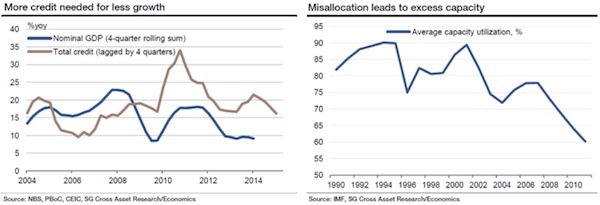
Source: Wei Yao & Claire Huang, “SG Guide to China Reform.” Societe Generale Research, May 14, 2014.
Moreover, state-perpetuated distortions in the cost and availability of financing are (1) funneling huge amounts of capital toward increasingly unproductive, state-directed investments, and (2) pushing household and private business borrowers into the shadows, where the burden of substantially higher interest rates drags on household consumption.
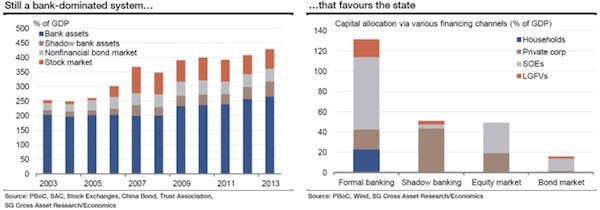
Source: Wei Yao & Claire Huang, “SG Guide to China Reform.” Societe Generale Research, May 14, 2014.
It doesn’t require much imagination to connect the dots. Structural distortions in Chinese financial markets are a major cause of debt-fueled overinvestment; and without sweeping structural reforms (along with a major crackdown on corruption at all levels of government), captive capital will continue to flow toward unproductive investments, capacity utilization will continue to fall, and China’s investment boom will continue its march toward a mega Minsky moment.
Like what you're reading?
Get this free newsletter in your inbox every Saturday! Read our privacy policy here.
This kind of structural distortion is a classic symptom of an overextended investment boom and a warning sign that rebalancing – whether it’s induced by voluntary reforms or an involuntary debt crisis – will not be easy. The critical adjustments – gradual deleveraging and structural rebalancing – will require a greater slowdown in economic growth and a sharper fall in still-bubbly asset prices than China’s policymakers are letting on.
“This is not an easy task,” The Daily Telegraph’s Ambrose Evans Pritchard says, in a truly brilliant article published this week, “not least because land sales and taxes make up 39% of state revenue in China, and the property sector employs 20% of workers one way or another. It is clearly a bubble of epic proportions and already losing air. Mao Daqing from Vanke – China’s top developer – says total land value in Beijing has been bid up to such extremes that is on paper worth 61.6pc of America’s GDP. The figure was 63.3pc for Tokyo at the peak of the bubble in 1990.” Yikes.
As Peking University professor Michael Pettis explains in his 2013 book, Avoiding the Fall: China’s Economic Restructuring, “Every country that has followed a consumption-repressing, investment-driven growth model like China’s has ended with an unsustainable debt burden caused by wasted debt-financed investment. This has always led to either a debt crisis or a lost decade of very low growth.”
China’s “miracle” is no different from any other investment-driven growth binge where high levels of leverage (directly or indirectly paid for by the household sector), combined with high levels of fixed investment, eventually result in excessive and unsustainable debt loads. Pettis elaborates:
While these policies can generate tremendous growth early on, they also lead inexorably to deep imbalances. As demonstrated by the history of every investment-driven growth miracle, including that of Brazil, high levels of state-directed subsidized investment run an increasing risk of being misallocated, and the longer this goes on the more wealth is likely to be destroyed even as the economy posts high GDP growth rates. Eventually the imbalances this misallocation created have to be resolved and the wealth destruction has to be recognized. What’s more, with such heavy distortions imposed and maintained by the central government, there is no easy way for the economy to adjust on its own…. [Furthermore], Beijing [will] not be able to raise the consumption share of GDP without abandoning the investment-driven growth model altogether.
In other words, the world’s second largest economy is approaching its debt limit and the end of the line for investment-led growth… but China’s financial system is structurally designed to prevent capital from flowing freely toward more productive uses. One way or another, the world’s largest contributor to global economic growth must slow down – either because Beijing has the foresight, resolve, and political capital to pursue aggressive economic and financial market reforms or because party elites fail to address the country’s structural imbalances and policy-induced distortions before the credit bubble pops. “Debt,” Pettis explains, “as we will learn over the next few years in China, has always been the Achilles’ heel of the investment-driven growth model…”
Which Way to Sustainable Growth?
Among the various reforms set forth in last November’s Communist Party Third Plenum, ranging from financial liberalization to a crackdown on corruption and pollution, the most challenging is the gradual deleveraging of the Chinese economy while simultaneously rebalancing the national economy toward a more sustainable, consumption-driven growth model.
According to Bob Davis and Lingling Wei at the Wall Street Journal, “That would be a departure from China's old formula of relying on cheap exports abroad and vast investment at home in building roads, railways and even new cities…. Standing in China's way are many of the biggest beneficiaries of China's past growth model.”
The transition will not be easy and may require a far greater slowdown than anyone in Beijing publicly admits. While China’s ruling elite don’t appear to be in denial about its debt problem, the distortions caused by widespread corruption, or the urgency to replace its sputtering growth model, the jury is still on whether President Xi Jinping will maintain the political and social capital necessary to follow through on growth-disrupting, job-displacing reforms.
Dr. Pettis suggests China’s central planners must choose among six possible paths, and the results of that choice will shape China’s future economic success or failure as forcefully as Deng Xiaoping’s Open Door policy did in 1978. We should all be praying for President Xi and his economic policy architect Liu He to choose wisely and follow through:
- Beijing can do nothing, maintaining its high investment growth rate, until it reaches its debt capacity limit, after which a sudden stop in investment will force up the household share of GDP, albeit in an outright recession.
- Beijing can quickly reverse the transfers that created the imbalances by, for example, pushing up wages and raising real interest rates sharply, forcing up the foreign exchange value of the currency by 10 to 20 percent overnight, or by lowering income and consumption taxes.
- Beijing can slowly reverse the transfers in the same way as outlined in path #2.
- Beijing can directly transfer wealth from the state sector to the private sector by privatizing assets and using the proceeds directly or indirectly to boost household wealth.
- Beijing can indirectly transfer wealth from the state sector to the private sector by absorbing private-sector credit (a virtually guaranteed lost decade).
- Beijing can cut investment sharply, resulting in a collapse in growth, but it can mitigate the employment impact of this collapse by hiring unemployed workers for various make-work programs and paying their salaries out of state resources.
It will be a sight to behold if China’s central planners can successfully rebalance the economy away from the exhausted fixed-investment and export growth engines toward a truly consumption-led economy… but they are attempting something that has never been done before, and the odds (and the historical record) are not in their favor.
Irrespective of the chosen path toward rebalancing, growth is clearly decelerating across the Middle Kingdom… and even a modest slowdown will shake the world.
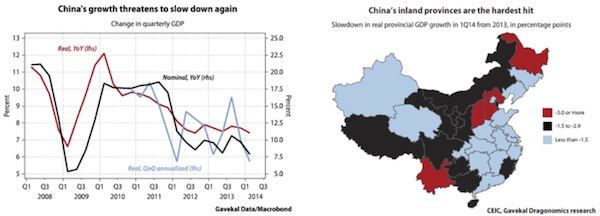
Source: Chen Long, “Testing the Reformers Resolve.” GaveKal Research, May 27, 2014
Our newly illuminated view via the China Beige Book leads John and me to believe that a pronounced slowdown (again, induced either by voluntary reforms or by an involuntary debt crisis) is now inevitable… suggesting that the real story surrounding China’s slowdown is really about the rest of the world, from its trading partners to leveraged investors in seemingly unrelated niches of our highly interconnected global financial system.
Our world is far more integrated today in terms of cross-border flows in goods…
Like what you're reading?
Get this free newsletter in your inbox every Saturday! Read our privacy policy here.
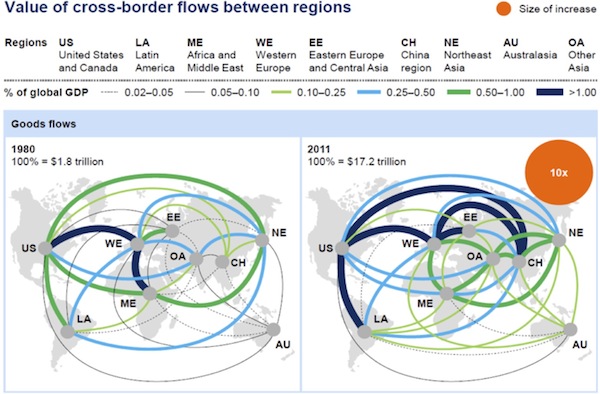
… services…

… and financial flows.
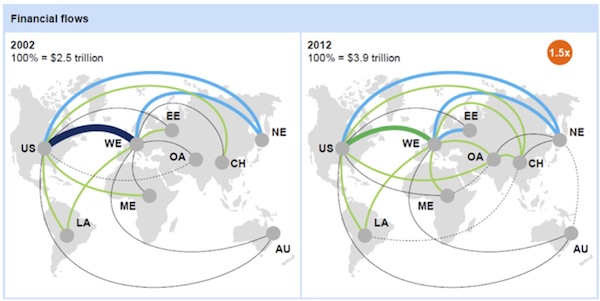
Source: James Manyika, Jacques Bughin, Susan Lund, Olivia Nottebohm, David Poulter, Sebastian Jauch, and Sree Ramaswamy, Global Flows in a Digital Age. McKinsey Global Institute, April, 2014.
We rarely know in advance which hedge fund or mega-bank has massive, leveraged exposures to toxic markets or asset classes, but it is absolutely prudent to assume that at least one systemically relevant institution has over-gorged and over-leveraged on positive carry. That’s a fair assumption, since major central banks continue to promote bad behavior with negative real interest rates, large-scale asset purchases, and forward guidance that chaotically distort market signals.
Any kind of deflationary collapse in China could send a shock wave through the world’s hyperconnected and highly leveraged financial system, triggering extensive losses in European and American mega-banks and likely tipping the developed world back into a hard recession precisely when the central banking community lacks effective policy tools to soften the blow. As we all experienced in 2008, such a shock could effectively shut the door on global trade finance, unwind carry trades around the world, and trigger a sharp reversal in cross-border capital flows as international trade grinds to a halt.
That’s a worst-case scenario that could certainly happen, but it’s not the most likely scenario (thank goodness). However, China doesn’t have to experience a deep recession in order to disrupt global growth.
China is the world’s second largest goods importer, buying the equivalent of more than $1.7 trillion in foreign goods each year (compared to US imports of roughly $2.3 trillion). The Middle Kingdom imports extensively from its immediate neighbors in East and Southeast Asia but also does nontrivial business with Australia, Brazil, the United States, and Germany. (Note: The following analysis relies on 2011 trade data, which is the most recent data-set available in MIT’s online Observatory of Economic Complexity).
Origin of Chinese Imports, 2011
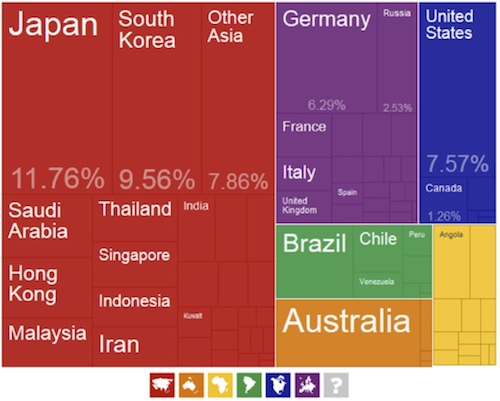
Source: Observatory of Economic Complexity, 2011
As a result, China accounts for nearly 28% of all Australian exports…
Destination of Australian Exports, 2011
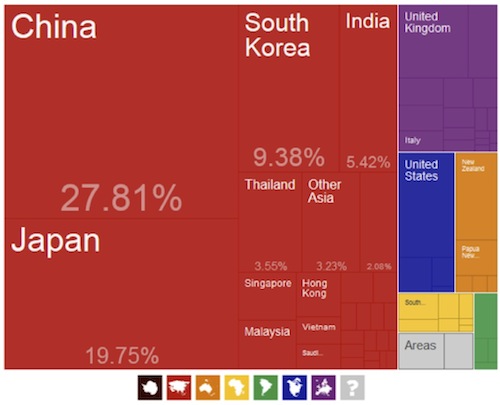
24% of all South Korean exports…
Destination of South Korean Exports, 2011
Like what you're reading?
Get this free newsletter in your inbox every Saturday! Read our privacy policy here.
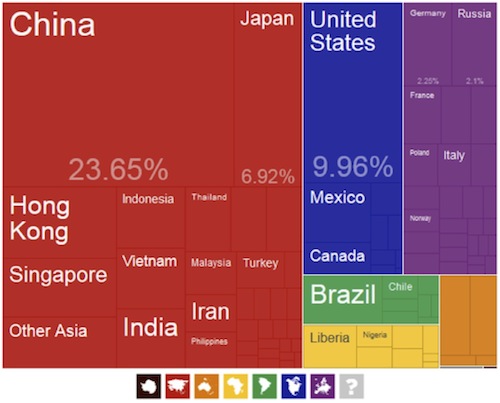
19% of all Japanese exports…
Destination of Japanese Exports, 2011
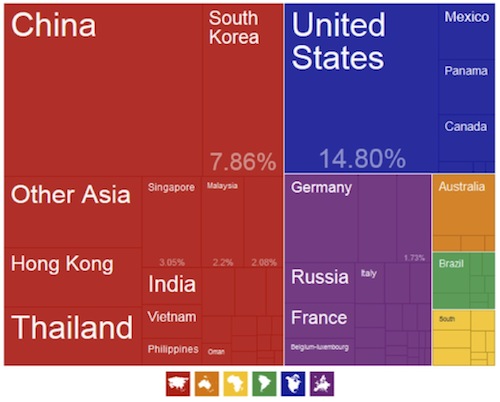
14% of all Malaysian exports…
Destination of Malaysian Exports, 2011
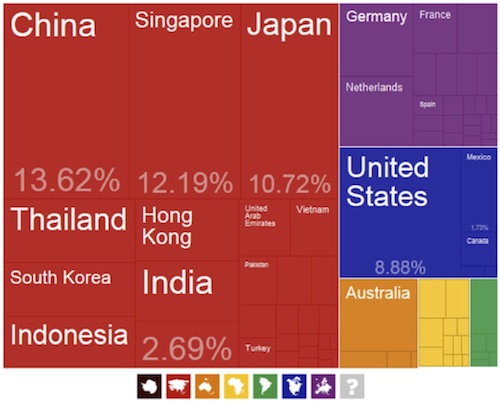
12% of all Singaporean exports…
Destination of Singaporean Exports, 2011
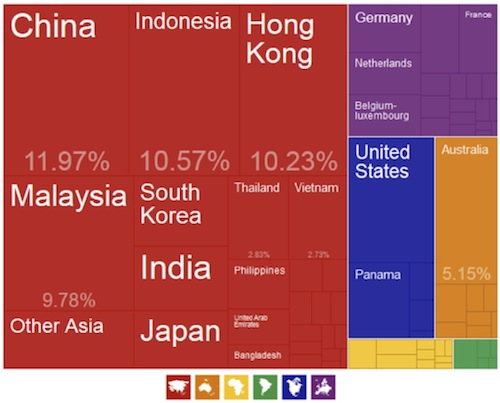
12% of all Indonesian exports…
Destination of Indonesian Exports, 2011
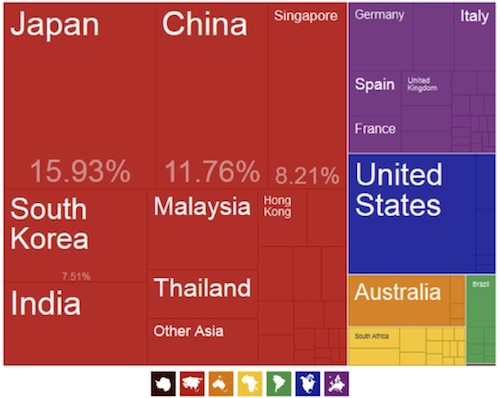
and 6% from Europe’s export-led economic hegemon, Germany.
Destination of German Exports, 2011
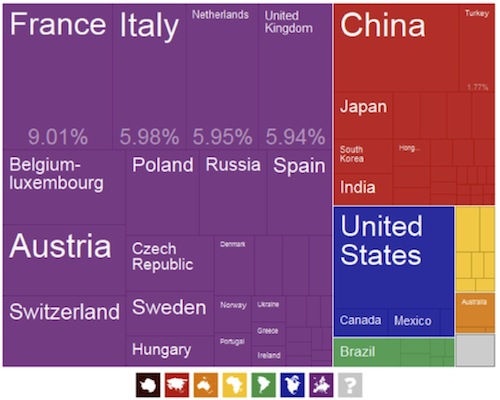
Source: Observatory of Economic Complexity, 2011
Like what you're reading?
Get this free newsletter in your inbox every Saturday! Read our privacy policy here.
If China’s GDP growth slows to 2–3% (a trend which may already be in progress), a corresponding decline in China’s appetite for commodities and other imports could fire a demand shock across all of these economies and even seriously impact Germany, which simply cannot afford a sudden disruption in its trade surplus if it hopes to preserve the euro system and keep its own banks afloat.
Considering the worst-case-scenario consequences for the world’s leveraged and interconnected financial markets, and the base-case potential for serious demand shocks to many of China’s suppliers, China’s slowdown represents a macro sea change – the kind we cannot ignore.
As John and I spoke with friends at his Strategic Investment Conference last week – brilliant people like Niall Ferguson, Ian Bremmer, Anatole Kaletsky, David Tice, Lacy Hunt, Dylan Grice, Grant Williams, Jonathan Tepper, Kyle Bass, Rich Yamarone, David Rosenberg, Raoul Pal, Neil Howe, and Jack Rivkin (to mention just a few) – we found everyone worried about China, and we spent late nights talking through the potential linkages.
Although the publicly available data can be murky, misleading, and inherently flawed, this is an area we must pay attention to in the coming months and quarters. China’s slowdown, deleveraging, and rebalancing are the most important macroeconomic forces in the world today… because they are the biggest unknowns.
We can get our heads around the risks in Europe, the United States, or even across the most fragile emerging markets; but it is impossible to know how long Beijing’s central planners can keep the investment boom going or whether they have any chance of keeping growth above 5% without precipitating a hard landing. That uncertainty leaves us with an incredibly wide range of possible economic outcomes (from a raging bull market in the case of a successful transition to a sharp collapse with global consequences when the credit-driven investment boom inevitably falters) and no way to intelligently assign probabilities. The situation in China demands close attention to risk in a world where very few investors are paying attention.
Remember: “China is like an elephant riding a bicycle. If it slows down, it could fall off, and then the earth might quake.”
Cross the River By Feeling the Stones
John here. Every time I go to Singapore I hear this story about Deng Xiaoping. It is said he came to Singapore in the late ’70s and saw the progress there under the leadership of one of the great men of the last century, Lee Kuan Yew. Supposedly he said something like, “These are Chinese people doing this. We can too.” He went back to begin the reforms that produced the results we see today.
In my opinion he is one of the most important of a small handful of leading figures of the 20th century. It is impossible to think of a modern China today without Deng Xiaoping.
Inheriting a country fraught with social and institutional woes resulting from the Cultural Revolution and other mass political movements of the Mao era, Deng became the core of the "second generation" of Chinese leadership. He is considered "the architect" of a new brand of socialist thinking, having developed "socialism with Chinese characteristics" and led Chinese economic reform through a synthesis of theories that became known as the "socialist market economy". Deng opened China to foreign investment, the global market and limited private competition. He is generally credited with developing China into one of the fastest growing economies in the world for over 30 years and raising the standard of living of hundreds of millions of Chinese. (Wikipedia)
When we discuss the future of China, it is important that we develop some perspective. Go back to 1978 and the economic disaster that Deng Xiaoping faced. China was coming off the Cultural Revolution, which had seen Deng himself purged at least twice, forced into menial work, and his son tortured. The hard-core party elite saw Deng as a huge threat.
If in 1978 someone had shown you a photo of a city like Shanghai or Beijing today and asked you the odds of that happening within 36 years in China, you would have laughed at them. What if that someone had told you then that 250 million people would be moved from the country into the cities and modern jobs created for them? That some of the most important companies and richest citizens the world would be based in China? And that China would be the second largest economy in the world with the potential to become the largest not long thereafter? By this time you would be rolling on the floor laughing, tears in your eyes. Such a thing would have been impossible to imagine in 1978.
In a stroke of good timing, Worth has just thrown the following images up on Twitter:
a. Shanghai in 1987
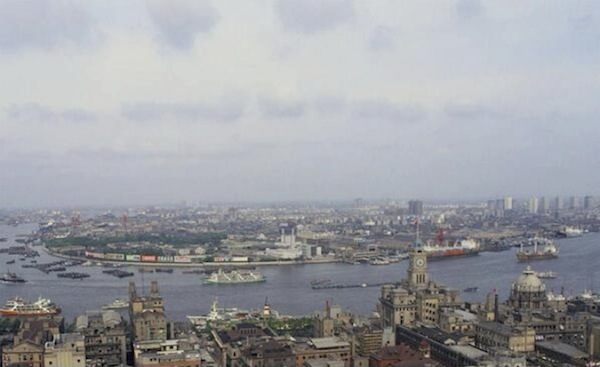
b. Shanghai in 2013
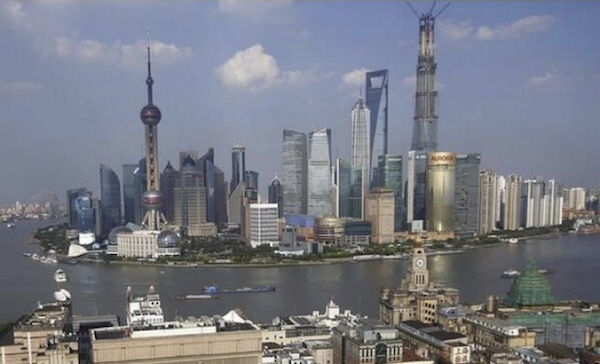
Like what you're reading?
Get this free newsletter in your inbox every Saturday! Read our privacy policy here.
(Readers can follow us on Twitter at @JohnFMauldin and @WorthWray.)
To get a sense of the history and significance of those times, let me direct you to a marvelous series of interviews with Lee Kuan Yew in his later years. For those who still want more, there is a marvelous biography of Deng Xiaoping called Deng Xiaoping and the Transformation of China, by Harvard professor Ezra Vogel. There are also YouTube videos with Professor Vogel.
One of the challenges faced by all those who attempt to do economic analysis is to keep our biases in check. All too often our forecasts agree with our personal beliefs.
I must confess that one of my cornerstone beliefs is that free markets are superior to centrally controlled markets. It is not just Hayek vs. Keynes, but Hayek vs. Marx. Westerners are still liable to consider China to be the same sort of command economy it was in the 1970s. But the China of today is vastly different, even though there are significant remnants of the centrally controlled economy. It is far too easy to see the growth of China in terms of centrally planned malinvestment based on leverage and construction and a real estate bubble of epic proportions that must end in tears. Such a stance dismisses the massive entrepreneurial and private-sector contributions that are at the core of the “Chinese miracle.”
In a very true sense, Deng Xiaoping slowly and thoughtfully introduced capitalism to China. And the Chinese have responded enthusiastically. The business acumen and entrepreneurship of the Chinese diaspora throughout the world over the last two centuries is legendary. Why would we not think the same cultural forces would be at work inside China, waiting to be unleashed?
We’ve spent the last two letters acknowledging the rather severe problems China faces. There is no question that one of the greatest real estate bubbles of the last two centuries has developed in China and that it is massively leveraged. Capitalism is generally messy, and the Chinese have created a dragon-sized monster of a mess. The corruption I mentioned in my opening appears to be somewhat rampant, distorting the use of capital in ways that produce uneconomic results. Many of the state-owned enterprises (SOEs) are hopeless basket cases and should be allowed to die, their assets sold off to new owners who can hopefully figure out how to put them to better use.
The banking system has often allocated capital according to political rather than economic ends, and it doesn’t take an economic rocket scientist to figure out what the results will be. There are trillions of dollars of bad loans in the Chinese system. It is quite easy to look at these problems and forecast a rather stark ending.
When I look at Japan or France (or the US prior to the subprime crisis), I have no problem making a firm forecast, either positive or negative, because I feel I have some understanding of the problems and can diagram a decision tree and ponder the results of possible decisions. As I have noted numerous times, Japan is faced with the rather stark choice of either Disaster A or Disaster B. I can see no decisions they can make that do not end up in economic turmoil. Ditto for France. I am hopeful that the US will use the small amount of time it has left to make the right decisions on entitlements and the budget. I can still see a possible path that could lead to things turning out well.
However, when I look at China, the decision tree is not only huge, it has questionable roots in the data. There are some branches, some paths to the future, that could turn out to be semi-benign. But in China, as in the US, I can easily see choices that will create domestic turmoil and macroeconomic chaos around the world. In both countries, big, hard decisions must be made, but it is not clear that we or they will make them.
In China, Xi and Li, if they stick to their announced program (and it appears so far that they intend to), promise to become the most important and most revolutionary leaders since Deng Xiaoping. What they are attempting to do is no less difficult than the task Deng was faced with in 1978. The problems are just different in character.
No country in the history of the world that I’m aware of has been able to allow a massively leveraged bubble to pop without creating economic turmoil. But then I can’t remember when a country with resources as vast as China’s has tried to proactively manage a bubble. Can a centrally controlled economy (which has never really worked in the long run) pull this off? Can China switch to a consumer-demand-driven, decentralized system without major disruptions?.
The Chinese do have some considerable advantages that should not be readily dismissed. For one they have a highly educated population. The government of the country consumes a smaller proportion of GDP (if you factor out SOEs), relatively speaking, than the governments of any of the developed-world countries do; taxes are relatively low; and the Chinese people are significant savers, far more so than their Western counterparts, which gives them a large capital base for expansion. They also hold a few trillion dollars in foreign capital (which I expect them to use). And rather than spending their income trying to drive consumption, they are spending on infrastructure that is there to be used by their established businesses and entrepreneurs (in contrast to the Keynesian-fueled US deficits, for which we have little to show!).
Further, their consumer market is nowhere close to being optimized. There is massive room for growth in the consumption of all types of products and services, which of course makes China ripe for a burst of entrepreneurial growth to counterbalance the significant deleveraging that will be forced upon them as they try to slowly let the air out of their debt bubble.
Xi and Li seem determined to deal with the corruption that is endemic to much political and business activity in China and to redirect the focus of economic activity from land sales and real estate construction to the production of goods and services. If the absolute rule of law cannot be established, the difficulty of attaining these goals will be significantly increased. Further, they have to allow nonviable businesses and banks to go bankrupt in an orderly fashion without threatening the overall system. That is not an easy task. But the Chinese leadership appears to be taking on the tasks, including labor reforms, that will be required if they are to navigate the treacherous waters in which they find themselves.
And the Chinese must do this as all the major central banks of the world are creating a significant imbalance by holding interest rates far below the Wicksellian “natural rate” and creating all sorts of potential bubbles and malinvestments, while driving currencies to unnatural valuations. China’s biggest problem may be outside its borders as a world devolves into a major currency war and the protectionism that typically follows. As if they don’t have enough to worry about with their own internal bubbles.
To be sure, I can’t see a path that will result in 7.5% annual growth for the next 10 years. That train has left the station. But is there the possibility of more “normal” growth, with the occasional business-cycle recession? If they can continue to unleash the power and drive of their private sector and not continue to prop up failing state-owned enterprises, pumping money into investments that have no final positive economic result, those measures will go a long way to solving the quandary they are in.
Like what you're reading?
Get this free newsletter in your inbox every Saturday! Read our privacy policy here.
As Worth pointed out above, 3% growth for China would require significant realignment of expectations in markets around the world. That outcome would be frustrating for those directly involved but not a disaster for the world as a whole.As I said at the conference, the world needs the Chinese to succeed. The world needs a functioning, growing China that is a responsible member of the global community and a force for stability.
If the Chinese get this wrong, we will face one of the most significant macroeconomic upheavals of our lifetimes. If they get it right, they could continue to be a key factor for global GDP growth.
Every night when we go to bed and say our prayers, we investors should mutter something along these lines: “Now I lay me down to sleep [insert personal requests], and please, God, bless the leaders of China and give them the wisdom to not screw it up.”
This letter is already longish, so there is no time to do more than acknowledge the very real and important geopolitical dance that is taking place in the South China Sea. Many of my friends, when they come back from China or Japan or both, express deep concern that things could spiral out of control. Both countries seem intent on proving something that quite frankly many of us in the rest of the world simply cannot get our heads around. Not to mention the involvement of Vietnam, the Philippines, Taiwan, and Korea, all of which feel they have rights in those waters. And there doesn’t seem to be anyone who can make them all play nice in the sandbox.
There was a time in the history of this letter when we paid a lot of attention to the US subprime crisis or to the problems in Europe or those of Japan. There are still significant negative forces in those regions and elsewhere around the world. But now we must begin to pay close attention to China. How the Chinese navigate their problems will have significant impact on our economies, our businesses, and our investments. For the macroeconomic world at large, there are a LOT of balls in the air. Unlike in 2006, when everything was just fine, there are now plenty of topics available for future letters. Shoot me a note with your suggestions. I do pay attention.
If you are a qualified purchaser or a licensed investment advisor qualified to make private placement recommendations, please join me and my partners at Altegris for an exclusive webinar featuring a couple of investment industry heavyweights, Richard Perry and Jack Rivkin. Richard founded Perry Capital in 1988 and is one of the originators of event-driven investing – a strategy where hedge fund managers expect big opportunities this year. My friend Jack, as many of you know, brings over 45 years of direct investing, research, general management, and investment management experience at leading financial institutions to his new role as Altegris CIO.
The webinar takes place on Tuesday, June 24, at 1:00 p.m. EDT / 10:00 a.m. PDT. Be sure to register here for this event, as it is sure to be one of the more interesting discussions of the year.
Upon qualification by my partners at Altegris, you will receive an email invitation. I apologize for this discussion being limited to qualified purchasers and investment advisors, but we must follow the rules and regulations. I look forward to having you at this exclusive event. (In this regard, I am president and a registered representative of Millennium Wave Securities, LLC, member FINRA.)
Trequanda, Rome, Nantucket, New York, and Maine
For the last seven days I have been pleasantly surrounded by the Tuscan countryside. The weather’s been perfect, and the conversations in the evening have been both enthusiastic and enlightening. I can’t tell you how much I’ve enjoyed spending the last six days with George Gilder. Not only is he a fount of intellectual insights, he is a never-ending source of great stories. I have to rank him right up there with the all-time great raconteurs I have met over the years.
George has been working on his latest book, on a new economic theory of money with a healthy dose of bitcoin thrown in. And I don’t want to give away too much, but let’s just say that there was an interview with the mystical, if possibly mythical, demiurge Satoshi Nakamoto held late at night in the grotto here in the villa in Trequanda. The world will just have to wait for George’s book to arrive to learn the details.
It’s getting close to time to hit the send button, as we leave in an hour to go to Florence (Firenze) to see the sights and in particular for me to once again see Michelangelo’s statue of David. I’ll again be spending the coming week close to “home” here in Trequanda, thinking about, outlining, and writing portions of my next book.
Then next Saturday I will leave for Rome, where I will spend four days with my good friend Christian Menegatti of Roubini Global Economics, meeting with bankers and policymakers to try to get a handle on Italy in particular and Europe in general. And maybe we’ll take a few side trips to see some of the marvelous historical sites.
Then it’s back to Dallas, where I will more or less stay for a month before heading out to Nantucket and New York City for a week, and then of course it will be time for our annual fishing trip out in the Maine boondocks, sometimes called the annual meeting of the Shadow Fed, organized by David Kotok of Cumberland Advisors.
One of the great benefits of being here in Tuscany is the local food. In addition to some fabulous restaurants, we have been able to find local chefs who will come in and make meals from scratch. Every night is a feast, but a healthy one.
Like what you're reading?
Get this free newsletter in your inbox every Saturday! Read our privacy policy here.
One of the great revelations is that the gardener for the villa here, Ivo, a 70-something spry little elf, is a fabulous cook. Yesterday he came in the early afternoon to begin his preparations, bringing with him only fresh ingredients straight out of his garden. I have always said that one of the great joys of life is a perfect tomato, and Ivo may be the ultimate source of that joy. He literally spent hours hand rolling the spaghetti pasta, and I’m not quite certain what he did to the chicken, but it had the table in awe. It is such a delight to watch him singing old Italian songs (he does a mean Dean Martin) and literally dancing around the kitchen. This is a man who knows how to enjoy life. I really don’t think he is worried about whether there is a bubble in Chinese debt – if he is worried about anything at all. We should all try to figure out how to be more like Ivo.
They are telling me the cars are ready to roll, so that means it’s time to take my leave. Have a great week. Next week Ivo promises lasagna. I hope you can have a few great meals of your own.
Your thinking I need to visit China analyst,

John Mauldin
P.S. If you like my letters, you'll love reading Over My Shoulder with serious economic analysis from my global network, at a surprisingly affordable price. Click here to learn more.
Put Mauldin Economics to work in your portfolio. Your financial journey is unique, and so are your needs. That's why we suggest the following options to suit your preferences:
-
John’s curated thoughts: John Mauldin and editor Patrick Watson share the best research notes and reports of the week, along with a summary of key takeaways. In a world awash with information, John and Patrick help you find the most important insights of the week, from our network of economists and analysts. Read by over 7,500 members. See the full details here.
-
Income investing: Grow your income portfolio with our dividend investing research service, Yield Shark. Dividend analyst Kelly Green guides readers to income investments with clear suggestions and a portfolio of steady dividend payers. Click here to learn more about Yield Shark.
-
Invest in longevity: Transformative Age delivers proven ways to extend your healthy lifespan, and helps you invest in the world’s most cutting-edge health and biotech companies. See more here.
-
Macro investing: Our flagship investment research service is led by Mauldin Economics partner Ed D’Agostino. His thematic approach to investing gives you a portfolio that will benefit from the economy’s most exciting trends—before they are well known. Go here to learn more about Macro Advantage.
Read important disclosures here.
YOUR USE OF THESE MATERIALS IS SUBJECT TO THE TERMS OF THESE DISCLOSURES.
Tags
Did someone forward this article to you?
Click here to get Thoughts from the Frontline in your inbox every Saturday.

 John Mauldin
John Mauldin
